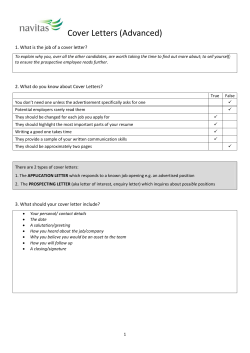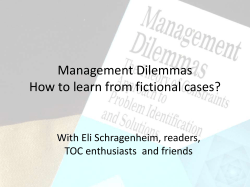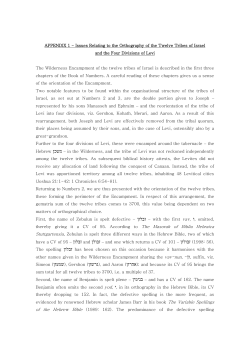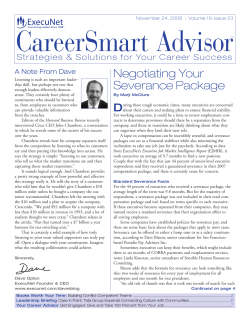
Cold Calling 2.0 Build a Sales Machine
Cold Calling 2.0 Excerpted from the new book, Build a Sales Machine, by Aaron Ross Cold Calling 2.0 Cold Calling 2.0 means prospecting into cold accounts to generate new business without using any “cold calls.” I define a cold call as “calling someone who doesn’t know you and who isn’t expecting your call.” That sucks for both the caller and called, right? Cold Calling 2.0 also means that new pipeline and leads are predictably generated – that is, an organization knows how “x effort” will lead to “y results.” In fact, it can be the most predictable source of pipeline at a company, when done right – as with companies like Salesforce.com, WPromote and Responsys. While Cold Calling 2.0 is a system with many steps, there was one original breakthrough that started the snowball rolling. In early 2003, I was experimenting with cold calling to see if it would work. It did – but far too slowly. In March 2003, I was able to generate two highly qualified opportunities (a core principle is to generate fewer opportunities that are much higher quality, rather than throwing over lots of random demos and appointments to Account Executives). I needed to be able to generate at least eight qualified opportunities per month to hit the ROI goals set by my managers. I had my own quality standards that I wouldn’t compromise, so I had to find a way to quadruple my results. OUCH. Breakthrough #1: The biggest bottleneck in prospecting into companies isn’t selling the decision maker/influencer/point person…it’s finding them in the first place! Oftentimes the ultimate decision maker – such as the CEO or VP Sales in the case of Salesforce.com, is not the best person for your initial conversations. I learned this through hard work – cold calling, cold emailing, plugging away. I realized I spent most of my time hunting for the right person – not trying to sell or qualify them. If I could find the right person, I could usually have a productive business conversation with them. It was just a pain in the ass to find them, especially in the F5000 size companies! In Desperation, I Tried An Experiment I’d always assumed that mass emailing executives wouldn’t work. Don’t I need to carefully craft each email to them to make it personal? © 2010 Aaron Ross. All rights reserved. Page 2 1. I wrote one email that was a classic, ‘salesy’, cold calling letter: “Do you have these challenges? X, Y, Z…” 2. I also wrote a totally different “short and sweet” email simply asking for a referral to the right person at the company. (I won’t be sharing email templates in this book for two reasons, which I will describe in a section just on email). I remember my experiment like it was yesterday. On a Friday afternoon, I sent two mass emails from Salesforce.com: 100 of the “classic salesy” emails to F5000 executives 100 of the “short and sweet” emails to the same kind of list. Out of 200 emails I sent, I had 10 responses back! Again, these were from C-level and VP-level executives at large companies. Response rate for the “salesy” email: 0%. Response rate for the “short and sweet” email: 10%. And at least five of the emails I received from the short and sweet campaign were positive, referring me to other people in the organization as the best person for a conversation about sales force automation. Breakthrough #2: Mass emailing C-level F5000 executives, with specific kinds of emails, can generate 9%+ response rates. Those high response rates (8-10% or more) from high-level executives have held true year after year, even with my current clients in 2010 (seven years later). A 500% Increase In the next month, April 2003, I increased my results by 500% and generated 11 qualified sales opportunities! Hence the tipping point of the Cold Calling 2.0 process was born: sending mass emails to high level executives to ask for referrals to the best person in their organization for a first conversation. The Complexities of High Volume & Growth It’s one thing for a single person to send out emails and generate responses in a week or a month; it’s another to create a regular stream of opportunities that come in from that person, and a whole team, year after year. © 2010 Aaron Ross. All rights reserved. Page 3 Your first email campaign is just a first step of a much longer journey. Much of the Cold Calling 2.0 content in this book (and outside of this book) relates to ensuring your system predictably generates results over the years, and with almost any kind of sales person or size of team. Why Aren’t Old Techniques Effective Anymore? Although once in awhile a cold call or classic new business letter might work, it’s becoming more rare. There are three dynamics in the market that have changed the nature of prospecting and what works: 1. Buyers are sick of being sold to, and become more resistant every year to classic sales and marketing methods, such as pushy cold calls or generic marketing materials. 2. Sales 2.0 technologies, both of CRM systems and Sales 2.0 applications, make it easier than ever to take the guesswork out of implementing, executing and auditing the ROI of a prospecting methodology. 3. More accountability in marketing spend. There is ever-increasing pressure for lead generation and marketing budgets to show documented proof of revenue results. Every project is scrutinized - “what’s the ROI? How do you know?” Executives want proof of revenue generated. Have you ever done a careful measurement of your cold calling programs? Chances are they are much more productive in terms of amount of activity than revenue. Executives are taking closer looks at these programs, and not liking what they see. How Is Cold Calling 2.0 Different? I define a cold call as “calling someone who doesn’t know you and who isn’t expecting your call.” Cold Calling 2.0 means prospecting into cold accounts without ever making any cold calls. More importantly, when executed systematically in high volume, an inside Sales Development team devoted exclusively to Cold Calling 2.0 can become the most predictable and sustainable pipeline engine (and thus revenue) for the company. Three key principles to developing a team successfully include: 1. No cold calling: prospect into cold accounts with new methods, rather than surprising people on the phone or trying to negotiate around gatekeepers. For example, use simple emails to generate referrals to the right people, who then will expect (and often welcome) a call. 2. A focus on results, not activities, which means that dials and calls per day are much less interesting or even important. Rather, track metrics such as qualification © 2010 Aaron Ross. All rights reserved. Page 4 calls per week, qualified opportunities per month or closed revenue sourced. Calls per day and dials are usually only tracked during training periods, for coaching purposes while reps ramp up their pipelines. 3. Everything is systematically process-driven, including management practices, hiring, training and, of course, the actual prospecting process. By emphasizing repeatability and consistency, the pipeline and revenue ramps generated by a new sales development rep become very predictable, and the entire team’s results become highly sustainable. Salesforce.com’s Cold Calling 2.0 Story In 2002, Salesforce.com had begun building a field sales organization dedicated to larger companies. To supplement the inbound leads they received (generated mostly through word of mouth), the field sales force was expected to prospect to bring in their own large deals. However, little was happening in the way of prospecting. Salesforce.com realized that in addition to the field people not making many calls because of their understandable dislike for cold calls, the ones who were trying to generate their own business were simply ineffective at it. The environment had changed, and the traditional prospecting techniques of the 1990’s weren’t working. Not only were cold calls ineffective, but they also targeted marketing programs offering high value items (such as business books) and produced disappointing results. Making the field sales people do cold calls means having your highest-cost (per hour) sales resource perform the lowest-value (per hour) activity. Salesforce.com decided it needed a new approach to create its own controllable, predictable source of new pipeline. We began the Cold Calling 2.0 project in early 2003, and spent a year testing and perfecting the methodology and system to prove its ability to add incremental revenue at a high ROI, before heavily investing in building a team around it. Why We Refined & Tested The Process For A Year While it took me four months to generate the first highly successful month of new opportunities and qualified pipeline, management had two valid concerns to address before they invested heavily: 1. Will the pipeline turn into revenue? Will the deals close? 2. Can junior sales people who aren’t Aaron do this? © 2010 Aaron Ross. All rights reserved. Page 5 We promoted a junior sales person to be a second member on my team. I trained him and he quickly began generating the same results as I. Also, over the second half of 2003, a significant amount of pipeline closed! We ended the year with more than $1,000,000 in new bookings (at least $3,000,000 in lifetime value)…that cost less than $150,000 to generate (about 1.5 fully-loaded salaries). No wonder that in early 2004 the Salesforce.com management team decided to grow the Cold Calling 2.0 effort from two people to 12! It was very hard for me to be patient and wait to grow the team, because I knew how effective the process worked. A nice benefit of waiting and refining was that when we began hiring, it was easy to ramp and train people, because I’d been developing my materials for so long. The team took off like a rocket! A key advantage we had was the Salesforce.com application itself. We would never have produced the same level of results without using Salesforce.com’s software. The traditional sales systems (such as ACT, Goldmine, Siebel) would have held us back, being slow, unintuitive and lacking the capabilities we needed around things like easy sharing of a common database, reporting and dashboards. They could have worked for a small team of one or two people, but they wouldn’t have been able to keep up with our team’s growth as we grew to six, twelve, twenty, etc. Despite some serious obstacles, which are detailed below, results quickly followed! (Revenue specifics per year are confidential). Serious Cold Calling 2.0 Challenges At Salesforce.com You might assume that the prospecting was easy ‘just because it was Salesforce.com’ (now a well-known brand) and that companies would take our calls. Nothing could be further from the truth. Although today Salesforce.com is a globally recognized brand company and the software-as-a-service (SaaS) licensing model is broadly accepted, back in the early and mid-2000’s: Salesforce.com was unknown and misunderstood in most companies. If someone had heard of Salesforce.com, they typically thought “don’t you offer outsourced sales teams?” Salesforce.com was pioneering the concept of software-as-a-service, offering its products online and on-demand; SaaS had not yet become accepted by mainstream companies. Furthermore, classic prospecting techniques just didn’t work. I decided to throw out all the books and legacy ideas and start from scratch. Because I had zero sales experience prior to salesforce.com, I had a fresh perspective. © 2010 Aaron Ross. All rights reserved. Page 6 All of these factors stood in our way – but we didn’t give up. The executive team gave me the time I needed (four months) to keep experimenting until I could create a process that worked. Cold Calling 1.0 Versus Cold Calling 2.0 Here are examples of the different intentions and practices of Cold Calling 1.0 versus Cold Calling 2.0. Notice it’s very similar to how sales has changed in general as well: Here are some further thoughts on what has changed: Develop respected experts: the Sales Development role is often treated within a sales organization as a low-level job. If you treat it that way, you’ll get low-level results. It’s a challenging and often thankless role. Treat the team as, and expect them to be, experts. Don’t skimp on training, equipping or developing them. Set high expectations of their ongoing skills development. Qualify accounts and contacts before calling: Cold Calling 1.0 involves calling or emailing into unfiltered industry-based lists of targets. Prospecting into accounts of marginal potential is the most common waste of time by Sales Development Reps and companies? Spend serious time on identifying and clarifying your Ideal Customer Profile. Define what companies are the most similar to your top 5-10% of your customers, defined as the ones likeliest to © 2010 Aaron Ross. All rights reserved. Page 7 purchase for the most revenue, and develop focused target lists based on these tight criteria. Research rather than sell: when reps do call into cold accounts, rather than cold calls, make “research calls.” The intention is different – rather than trying to get the decision maker on the phone, a rep simply learns about the company and whether there is even a potential fit or not. Blackberry-sized emails: Avoid sending long, salesy emails that no one reads. Send emails that are very short (readable on a Blackberry) and to the point. Be direct – what are you looking for? Go beyond basic CRM: Leverage your CRM system and Sales 2.0 applications in every way possible. Do you use dashboards? What about applications for de-duplication and data cleansing, contact acquisition, or tools that tell you when prospects that you are in touch with visit your website? There is a wealth of options now to enhance every step of your process – in fact, there are so many options it can be too confusing! Don’t let that stop you from constantly testing new applications to see what works for your company. Why Account Executives Should Not Make Cold Calls There are three problems with expecting your Account Executives (quota carrying sales people) - whether they are inside or field based - to be the ones to do all the work developing new accounts: 1. They don’t like to do it. 2. They usually aren’t any good at it. 3. It’s a poor use of company resources by using the most expensive sales role to do lower-value work. Where and When Account Executives Should Prospect Here are the rules of thumb about where Account Executives should spend their precious time prospecting: 1. A short, targeted “Top 5” or “Top 10” list of strategic accounts to penetrate. 2. Their current customer base. 3. Developing referral or channel partners. The point is to focus your highest value people on the low-volume but high-value activities (building relationships at key accounts), and specialize other roles and sales reps to take over low-value, yet high-volume, activities (prospecting into untargeted cold accounts). © 2010 Aaron Ross. All rights reserved. Page 8 About Aaron Ross Aaron is the founder of PebbleStorm, a community of people that enjoys helping each other succeed. Our mission is to help 100 million people “make money through enjoyment” by showing them how to shift the way they do business and become more successful by making their work enjoyable and inspiring. “Build A Sales Machine” is the sales consulting arm of PebbleStorm, helping companies create predictable revenue through more effective lead generation (Cold Calling 2.0), sales development processes and organizational design. Before PebbleStorm, Aaron Ross was an EIR (Entrepreneur-in-Residence) at Alloy Ventures, a $1 billion venture capital firm. Prior to Alloy, at Salesforce.com Aaron created a revolutionary sales lead generation process and team that helped increase Salesforce.com’s recurring revenues by $100 million. Aaron is also the cofounder of DataSalad (“Fresh B2B Marketing Data”), and on the advisory boards of Silicon Valley companies such as: Clickability, 4INFO, ConnectAndSell, AdaptAds, Playboox, AfterCollege, ExpertCEO and Flywheel Ventures. About Marketo Marketo is the revenue-focused marketing automation company, revolutionizing how marketing and sales teams of all sizes sell and succeed at every stage of the revenue cycle. Delivered in the Marketing Cloud, Marketo’s powerful and easy solutions provide the fastest time to value and ignite explosive revenue growth from the earliest stages of demand generation and lead management to the pursuit of revenue and customer loyalty. Marketo Lead Management helps Marketers acquire, nurture and qualify more high quality sales leads with less effort, while Marketo Sales Insight helps Sales understand, prioritize and interact with the hottest leads and opportunities to close business faster. Known for providing breakthrough innovation and the utmost in usability, Marketo was voted 'Best Marketing Automation Application' and 'Best Mass Emails Solution' by Salesforce customers on the Force.com AppExchange. As of January 2010, more than 400 enterprise and mid-market clients in 14 countries have selected Marketo. Call: +1.650.376.2300 Email: info@marketo.com Visit: www.marketo.com © 2010 Aaron Ross. All rights reserved. Page 9
© Copyright 2025





















